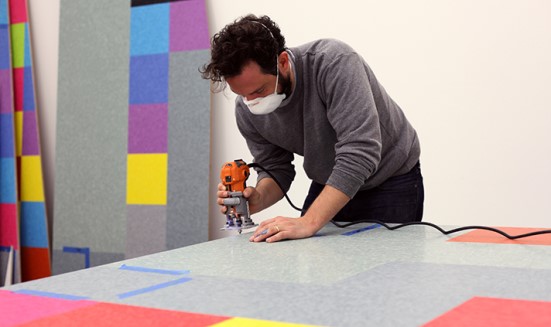Reset, the ambitious, multifaceted program that kicks off at the Pulitzer Foundation for the Arts this Friday, Jan. 17, features “Candy Crush,” a multi-colored tile floor by New York artist David Scanavino. The floor sculpture functions not only as a work of art, but also as a stage for a wide variety of performances and events throughout the program, which runs through Jan. 25.
ALIVE caught up with Scanavino and discussed his floor sculpture, the function of “Candy Crush,” and the new direction of his art incorporating color.
ALIVE: Do all of your works explore a consistent theme?
DS: I feel like they all have a similar theme. The three main bodies of work I’m exploring all make use of leftover materials that were in my immediate environment. I’m interested in objects like that. Objects that have a use and function, that are used but not necessarily looked at. That’s a theme that runs though all the work I do.
ALIVE: You’ve had some success creating floors. Tell me how the first one came about.
DS: With my first solo show in 2008, I really wanted to control the environment of the room, but in a way that wasn’t too obvious. I wanted it to be a little more subtle, a little more subversive. I chose the blandest color I could find, and I tiled the entire gallery space that color. That wasn’t enough. That was just me having tiled the floor. So I made a sculpture of those tiles that sat on the floor—a one-foot cube that was basically laminated with those tiles on every side. It was kind of a camouflage thing. People didn’t notice that cube when they first came in. So they were just walking around taking for granted that this floor was the floor of the gallery. Then eventually they came across that cube. Then they were aware that this whole thing had been orchestrated. It shifted their perception of where the art started and stopped. That was the first floor piece.
ALIVE: How does your floor installation at the Pulitzer, “Candy Crush,” broaden our knowledge or experience?
DS: These types of floors are very institutional, and they’re very social. They’re used in large social spaces like hospitals and high schools and environments like that. They’re not neutral. They’re designed to create particular emotional responses, but they’re not really noticed. By using the floor as a sculpture—one that you walk on—I think it changes your awareness of how you are walking around that room and I think it changes your relationship to the material. And then when you go out into the larger world and walk around in other spaces, you’re much more aware of the environment you’re navigating. One of the things I really love about the “Candy Crush” show is that we’re having all these events on it. Normally the gallery is a one-on-one, private thing. I like that were having these different social groups coming in to use it. I think that syncs up nicely with where I got the materials originally.
ALIVE: With “Candy Crush,” the floor extends up the wall. How does that transform the experience?
DS: When it goes up on the wall like that it’s a more radical shift. The floors start to take on an independence from the room. It’s much more dynamic. It’s like you’re walking into a painting. The colors are not random.
ALIVE: What are you working on right now?
DS: I have a solo show at the Aldrich Museum in Connecticut. That’s not for several months but I’m starting to work on that show. There’s going to be another floor piece for that, and I started a series of paintings made from construction paper—paper pulp—that are really bright colors. This piece (“Candy Crush”) really opened up a lot of color for me. I’m also doing a group show in New Zealand.
ALIVE: Do you see the use of color—inspired by your work at the Pulitzer—as a new direction for your art?
DS: I think so, yeah. For a long time the palette that I used was very institutional—that meant a lot of greens, browns and tans, and I was working with a lot of plaster. It was pretty muted, more tactile. But now this piece in particular just opened up a lot of really interesting color. I don’t think I lost anything by adding the color. I think I was timid before, but now I’m realizing that it’s an exciting ingredient and something I haven’t really pursued in the past. Right now color is becoming a very big deal for me.
ALIVE: To finish up, what excites you most about the show at the Pulitzer?
DS: The most exciting thing for me is to see these different groups interact with this piece and have it become part of a real social environment. That’s just a huge treat for me. I can’t wait to see that play out.
